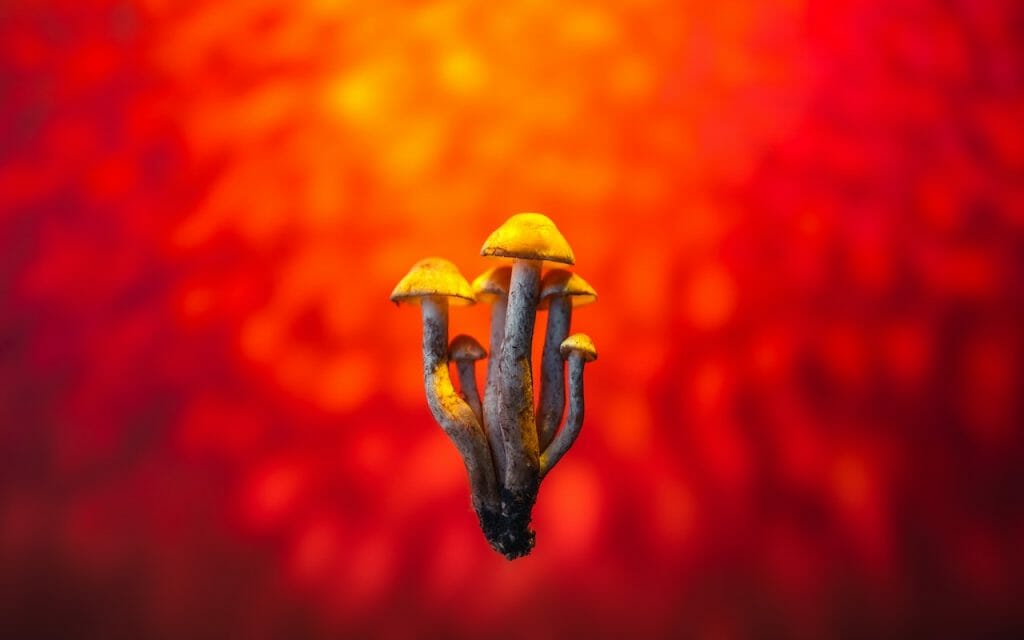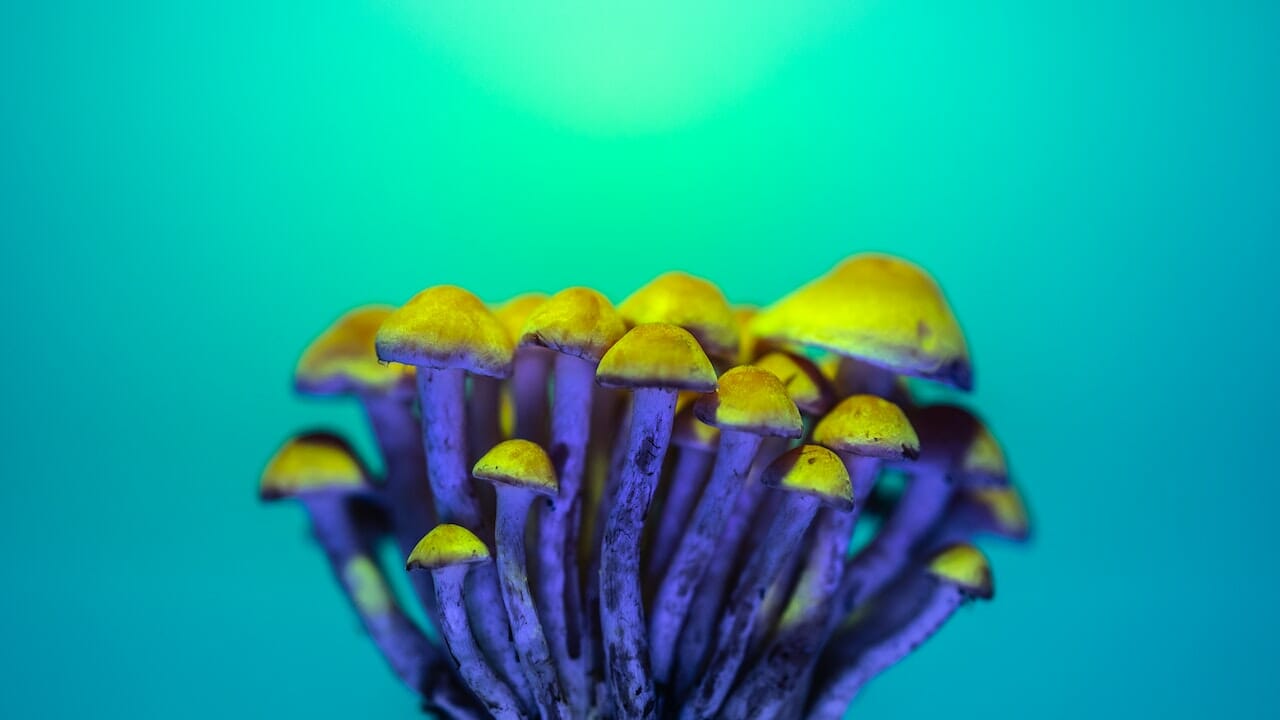Lysergic acid diethylamide (LSD) is a potent hallucinogen that has received considerable attention in psychedelic research. Initially known for its recreational use, LSD has evolved into a psychoactive substance with potential benefits for mental health. This shift in understanding has paved the way for further exploration of LSD’s effects, particularly in more consumable forms such as LSD edibles.
Key Takeaways:
- LSD is a powerful hallucinogen derived from the ergot fungus.
- LSD shares similarities with psilocybin and interacts with the 5-HT2A receptors.
- Consumption of LSD can result in visual alterations, mood shifts, ego dissolution, and pseudo-hallucinations.

Deciphering LSD
LSD is a remarkably potent hallucinogen that can profoundly alter one’s perception of reality and significantly distort the senses. LSD originates from “ergot,” a fungus that grows on rye and other grains.
At the molecular level, LSD is a complex chemical belonging to the ergoline family. It comprises a bicyclic hexahydroindole group and a bicyclic quinoline group (lysergic acid). The name ‘Lysergic Acid Diethylamide’ is derived from the functional group attached to its core. LSD’s structure resembles other ergoline alkaloids, for instance, ergotamine, found in the ergot fungus Claviceps purpurea, and the neurotransmitter serotonin.
The Effects of LSD
When consumed, LSD travels to the brain, instigating chemical responses that can last several hours. LSD might trigger the following short-term effects:
- Unpredictable mood fluctuations
- Distorted perception
- Feeling dizzy
- Decreased appetite
- Impaired motor control
The Advantages What are the Benefits of Using LSD?
The benefits of LSD are diverse and greatly depend on the dosage consumed. Most studies highlight the potential benefits of consuming this psychedelic substance in smaller amounts. In the following sections, we’ll discuss the positive outcomes associated with the use of LSD.
Pain Relief and Neuronal Development
Research conducted by scientists at Maastricht University indicates that a single microdose of LSD can offer pain relief for a minimum of five hours and potentially longer.
In the Cold Pressor Test, a procedure where participants immerse their hands in 3°C (37.4°F) water for as long as possible, results showed that participants who had taken 20 mg of LSD could keep their hands submerged for 20% longer compared to those who hadn’t. These participants also reported less pain and discomfort.
Furthermore, LSD can contribute to the growth and development of our brain’s 86 billion neurons. Moderate LSD doses, ranging from 5 to 20 ug, can increase BDNF levels in blood plasma. This is significant because mood disorders like depression, often associated with neuroplasticity problems, can potentially be mitigated by LSD’s positive impact on neuronal health.
Improvement of Mental Health
Dr. Robin Carhart-Harris from Imperial College London introduced the entropic brain theory. This theory asserts that mental health disorders are often rooted in rigid thought patterns, maintained by an excessively active default mode network (DMN). Psychedelics like LSD have the potential to disrupt DMN, enhance brain entropy, and aid in dismantling negative neural pathways while promoting the creation of positive ones.
A study involving over 1,000 microdosers revealed a reduction in depression symptoms. Another extensive cross-sectional study found a decrease in negative moods and harmful attitudes, as well as an increase in cognitive abilities and open-mindedness.
Addiction Treatment
A meta-analysis of randomized-controlled clinical trials involving LSD in psychiatry demonstrated its effectiveness in treating alcohol dependence. This is further backed by the successful results observed in many patients treated for alcoholism by Humphrey Osmond and at the Spring Grove Hospital Centre during the 1950s and 1960s.
Relief of Anxiety and Depression in End-of-Life Situations
Dr. Peter Gasser discovered that LSD-assisted psychotherapy could significantly reduce anxiety in terminally ill cancer patients related to their impending mortality, while also enhancing their perceived quality of life. Currently, a Phase 2 trial is underway to explore the potential effects of LSD therapy on depression.
Delving into LSD Edibles: Their Composition and How They’re Made
LSD edibles refer to a range of food and beverage items that incorporate the hallucinogenic substance, LSD. These can take many forms, from chocolates, candies, and baked goods, to more unique items, like LSD-infused mints.
The Ingredients
- LSD: This is the main compound that triggers hallucinogenic effects. It’s carefully measured and mixed into the edible.
- Edible Base: The LSD is typically dissolved or infused into a consumable substance such as a gummy, candy, sugar cube, or other ingestible materials. These substances act as carriers for the hallucinogenic compound.
- Flavouring and Ingredients: Depending on the specific edible product, flavourings, sweeteners, and other ingredients may be added to enhance the taste and texture. These can include natural or artificial flavourings, colours, and sugars, and can vary widely.
How They’re Made:
- LSD Synthesis: The process begins with the chemical production of LSD. This step requires an advanced understanding of organic chemistry and the necessary chemicals, equipment, and a laboratory environment.
- Liquid Formulation: Once the LSD is synthesized, it is usually turned into a liquid form by dissolving it in a solvent. This liquid acts as a concentrated LSD solution.
- Infusion: The liquid LSD is then infused into an edible medium like gummy candies, sugar cubes, or blotter paper. The medium absorbs the liquid, allowing for oral consumption of the LSD.
Experiencing the Psychedelic Effects of Psychoactive Compounds in LSD Edibles
LSD triggers intense visual effects. Colours seem more vivid, objects might appear to have halos or rainbows around them, and shapes can seem to transform. Regardless of whether their eyes are open or closed, users may see
LSD, with its vibrant, rapidly changing geometric patterns, among other visual distortions, is known to generate what are known as “pseudo-hallucinations.” This implies that while the individual is aware that these visions aren’t real, they are influenced by the drug’s effects.
LSD offers a pathway to alter one’s perception of themselves and their environment. The drug can induce a range of psychological states, causing thoughts to appear either profoundly clear and meaningful, or devoid of any logical coherence. Additional effects might include altered perceptions of time, distance, and body image. The boundary between self and the external world may appear fuzzy. Some individuals report sensory fusion experiences, such as seeing music or hearing colours.
Suggested LSD Products
There is a plethora of LSD-infused edibles available for purchase, but it’s critical to buy from a trusted dispensary. It’s important to verify that the edibles contain LSD and not other substances like PCP, ecstasy, or ketamine.
Deadhead Chemist – LSD Infused Gummies
Deadhead Chemist offers LSD-infused gummies, each containing 100 micrograms (ug) of LSD, in a range of flavours. Each package contains a single gummy, which has demonstrated potential in aiding individuals suffering from conditions like obsessive-compulsive disorder (OCD), post-traumatic stress disorder (PTSD), alcoholism, depression, and cluster headaches.
Deadhead Chemist – Mint Tea
Deadhead Chemist’s raspberry mint tea provides a tastier, and more flavourful way to experience the effects of LSD. LSD and other psychedelics act like the serotonin neurotransmitter and enhance the brain’s flow state.
Earthly Delights – Candy Flips
Candy flipping became famous during the late 1980s rave culture. Today, explorers and party animals continue to enjoy the sheer brilliance of these two amazing substances. Users often report intense feelings of love and connectivity, accompanied by captivating visual effects such as amplified colours, object metamorphosis, and complex geometric patterns.
Concluding Remarks
LSD has a historical connection to transformative experiences. As our comprehension of this substance has grown, so too has its popularity. The introduction of LSD-infused edibles provides a new way for people to experience its effects. These delectable delights have become a popular way to safely and enjoyably experiment with LSD in controlled doses.
As the leading provider in Canada of high-quality shrooms online, Magic Mushrooms Ottawa Canada boasts a broad array of LSD-infused edibles and cannabis products. Feel free to browse our selection at your convenience, add your favorite items to your cart, and unwind at home while we handle the delivery. Our assortment also includes a variety of psilocybin shrooms, edibles, beverages, and capsules for your convenience. Make sure to check out our LSD delivery page for additional details!
Frequently Asked Questions
What sets LSD apart from psilocybin?
CHARACTERISTICS LSD PSILOCYBIN Source A semi-synthetic chemical compound Naturally occurring in fungi Possible Forms Tabs, microdots, liquid, gummies, blotter paper Dried mushrooms, capsules, teas, chocolates Potency Highly potent, microgram doses (ug) Varies depending on mushroom species and preparation Onset and Duration Quick onset (15-60 minutes), short duration (3-5 hours) Gradual onset (30-60 minutes), moderate duration (4-6 hours)
How can one mitigate negative experiences with LSD?
- Choose Your Surroundings Wisely
- Prepare Your Mind
- Start with a Minimal Dose
- Ensure a Trip Guide
- Create a Calm Environment
- Use Deep Breathing and Grounding Techniques
- Accept and Release
How long do the effects last?
The LSD effects may begin to appear between 30-60 minutes after ingestion. Those with a heightened sensitivity to psychedelics might start to notice the effects In just a quarter of an hour, you’ll be able to determine if you’ve taken acid. The peak of your trip generally occurs around three hours into the experience. You might experience a sense of time distortion and hallucinations.
Hold on, feeling disjointed from reality during this stage is normal. The pinnacle phase continues for 3 to 5 hours, followed by an offset phase lasting another 3 to 5 hours.
How does LSD interact with the human body?
LSD primarily engages with the brain’s serotonin system by attaching to and stimulating the 5-HT2A receptor. This interaction sets off a sequence of neurochemical and physical responses. Certain factors can influence the diverse effects LSD can have.
Does LSD come in forms other than edibles?
Absolutely. LSD is available in a variety of forms. The four primary types of LSD products are blotter paper, liquid solution, tablets/microdots, and gelatin sheets.
Recommended Readings:
| CHARACTERISTICS | LSD | PSILOCYBIN |
| Source | A semi-synthetic chemical compound | Naturally occurring in fungi |
| Possible Forms | Tabs, microdots, liquid, gummies, blotter paper | Dried mushrooms, capsules, teas, chocolates |
| Potency | Highly potent, microgram doses (ug) | Varies depending on mushroom species and preparation |
| Onset and Duration | Quick onset (15-60 minutes), short duration (3-5 hours) | Gradual onset (30-60 minutes), moderate duration (4-6 hours) |





